![]()
![]()
![]()
Use LEFT and RIGHT arrow keys to navigate between flashcards;
Use UP and DOWN arrow keys to flip the card;
H to show hint;
A reads text to speech;
12 Cards in this Set
- Front
- Back
- 3rd side (hint)
|
How did death become religious? |

1. Death was considered normal after 1350 due to plague. 2. Lady Day and Michaelmas were used to pay loans but were religious holidays. 3. Mass became about the sacrifice of Christ, and Purgatory was avoided by gifting the church and being prayed for during Mass. 4. Pilgrimage was also performed to have a Saint’s protection from purgatory. 5. On your deathbed last rites prevented the Devil from entering your body. |
Normal after 1350, lady day/Michaelmas, Mass, pilgrimage, last rites |
|
|
What was the attitude towards death? |
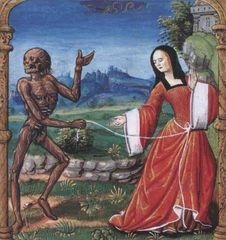
• Casual I.e. Henry I’s corpse proceedings in detail. • Mythological/religious I.e. Leicestershire ‘doom’ painting of the dead resurrecting, used at sermons as a preaching aid to remind others of the consequences of sin. • Lesson I.e. Doctrine of Purgatory is made 12-13th c. showing the prayers of the living can decide your fate. The 3 living and 3 dead manuscript - 3 princes meet 3 horrifying decomposing bodies who remind them ‘as I am you will be’. |
Henry I, doom painting, 3kings 3 corpses |
|
|
What are the features of Christian burial archaeology? |
•E-W burial •Intercut •No grave goods/furniture •Child graves underrepresented, maybe because they are buried elsewhere or too young to be considered. I.e. Spitfield St Helen on the Walls, 5 coffins, 27% child deaths, 1041 burials. Poor urban parish. Only 5 artefacts. Only 9% live over 60. •Raunds, Northamptonshire - entire cemetery excavated south side with no children. • Wharram Percy - 687 skeletons, osteoarthritis and squatting facets. • St. Margaret’s Bath Site Leicester - 1300+ bodies in a tight space, only 25 in coffins. • People want to be represented at 30 • 5’2” Female, 5’6” Males. |
Features intercut, direction, goods, child, raunds, WP, ideal age, average height. |
|
|
What grave goods are featured? |
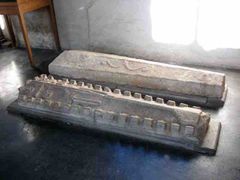
• Nails - Most common I.e. Aberdeen. • Shroud Pins I.e. Whithorn, Scotland • Shells I.e. Aberdeen for pilgrims, although wooden rods are also common. • Lead Chalice I.e. Spitlafields London for a priestly burial. • Coffins: rare, in monastic areas 4-34% of the time. Only 2% of graves have evidence of ritual deposition. • St. Mary Magdalen Leper women are buried 80% of the time, men 60%. |
Objects. Leper’s, coffins. |
|
|
What are some atypical burials? |

• St Bees Bodies - SK100, F, 50s and consumed fish: Lady Maud de Lucy. Bees man 35-40, had a love hair token: Anthony de Lucy. •Black Death: no skeletal evidence, no intercutting I.e. East Smithfield •Jewbury, York - 500 bodies forced reburial by Chief Rabbi, only 1.7% intercut. 5 had grave goods, most had coffins. (Evidence from older females, larger naval cavity, high orbits and teeth banding from starvation). 163 males and 151 females. • Decapitation I.e. St. Andrews priory stone supporting head. •Memorials - rare, upperclass. For ‘active’ prayer, thought I.e. Robert Curthose who was used in sermons. |
St. Bees, Black Death, Jewbury, decapitation, memorials. |
|
|
What about medieval memorials? |

Incredibly rare, only 2-3% survive. Mostly were marked by wooden markers which don’t survive. Pre-conquest burials had a lot of decorative monuments. I.e. Hogback tombs and Middleton Man Post-conquest monuments were mainly horizontal incised stone slabs with a cross I.e. Bakewell, Derbyshire, and Kirby Ravensworth bow and arrow grace. Effigies I.e. Eleanor of Castile Westminster Abbey, 12 crosses were built on her passage to Westminster. brass plaques to invoke prayer. Secular monuments began invading churches in families to compete with one another for prayer/sympathy. I.e. the de la Mare Family. Symbolised wealth and rank. They make previously public spaces privatised. Male ideals: ‘S’ collar for Lancastrian I.e. John Cressy, martial repose I.e. Ralph de Botiller, with a hunting dog and crossed legs for a military action, 30s. Female ideals: Virgin Mary and unrepresentative. I.e. Fledborough and Philippa de Courtenay |
Slabs, secular monument invasions, male and female ideal tombs. |
|
|
What were cadaver effigies and why did they exist? |
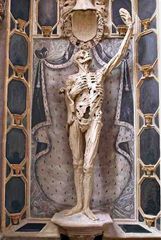
• A ‘memento mori’ •Grotesque, meant to evoke pity, prevents purgatory. It was first adopted by bishops and trickled down to the public. It is also linked to lords with Lancastrian sympathies. • Fashion from France, I.e. Jean de la Grange and ‘double decker’ I.e. Bishop Richard Fleming 1431. Henny Bentley - Thomas beresford and his wife in sacks. Tomb of John Baret |
Purgatory, memento mori, french |
|
|
What were the most common grave types? |

Medieval brasses as they were most affordable I.e. Laurence st. Maur shows they were popular with clerics first from 1270 introduction. sometimes a puzzle I.e. two women looking at one another, Elizabeth etchingham and agnes Oxenbridge at East Sussex. Produced by trained craftsmen who incise the slabs to fill with pigment I.e. brass of Richard de Hakebourne but there was a standard template. Cadaver brasses were also common I.e. Cecile Howard with a shroud covering them, but some had worms coming out of their orifices I.e. Ralph Hamsterley |
Brasses, puzzling |
|
|
Example of a memento mori in religion? |
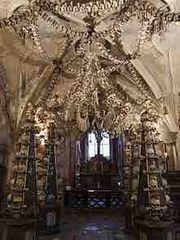
•The Bone Church in Czech Republic |
Bone |
|
|
What is an unusual example of a memento mori? |
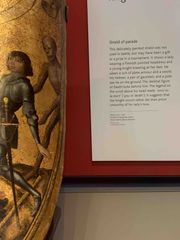
• A shield of parade on which is ‘death or you’. •There is emotional manipulation with the reminder of death as a threat. |
Death or you, parade shield. |
|
|
What is an unusual example of a memento mori? |

• A shield of parade on which is ‘death or you’. •There is emotional manipulation with the reminder of death as a threat, because they could die at any time. |
Death or you, parade shield. |
|
|
What is a challenge of excavating Christian cemeteries? |
1. They are still in use 2. It is rare for them to be available for excavation unless the entire church interior is excavated I.e. Barton-Upon-Humber has churches within churches and over 10k burials. |
Used, rare |

